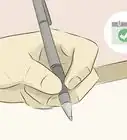This article was co-authored by Joel Giffin, PT, DPT, CHT. Dr. Joel Giffin is a Doctor of Physical Therapy and the Founder of Flex Physical Therapy in New York, New York. With over 15 years of experience as a Certified Hand Therapist (CHT), Dr. Giffin treats the whole body and specializes in rehabilitation of the hand and upper extremities. He has treated Broadway theater performers backstage at shows such as The Lion King, Sleep No More, Tarzan, and Sister Act. Flex Physical Therapy also specializes in occupational and pelvic floor therapy. Dr. Giffin earned his Master’s degree in Physical Therapy with honors from Quinnipiac University and received his Doctor of Physical Therapy (DPT) degree with distinction from Simmons College. He is a member of the American Physical Therapy Association and the American Society of Hand Therapists.
This article has been viewed 57,755 times.
If you write with your right hand, it is possible to train yourself to write with your left hand. This is useful if you happen to injure your right hand and cannot use it. Plus, in learning to use your left hand, you improve communication between the right and left hemispheres of your brain, which has been suggested to improve cognitive awareness, creativity, and abstract thinking. [1] This is done through strength training, exercises, and mental focus.
Steps
Strengthening Your Left Hand
-
1Weight train with your left hand. Use light weights to strengthen your fingers and wrist.
- The stronger your left hand becomes, the easier it will be to hold a pen/pencil.
- You’ll be able to focus on writing well if you’re left hand is stronger. This is because it won’t get fatigued as you attempt to write.
- Flexibility is just as important as strength. Keep your hand flexible to keep it from cramping when you start writing.
-
2Do daily tasks with your left hand. Once you’ve strengthened the fingers and wrist of your left hand, begin doing basic daily tasks. The more you use your left hand, the more comfortable you’ll be with it. Start out with the most basic tasks and work your way to more difficult ones.
- Eat and drink with your left hand. Cutting your food the opposite way and pouring drinks with your left hand will engage your brain as well as continue to strengthen your left hand. This is a good place to start because it won’t interfere with your daily schedule.
- Open and close with your left hand. Doors, buttons, bags, and drawers are all great places to start using your left hand. Remember that buttons and doorknobs that twist will be more awkward than drawers that simply slide open.
Advertisement -
3Switch your computer mouse. Many of us use our computer mouse for hours on end. Start to use your left hand to use the mouse of your computer. You can switch the mouse’s buttons easily with your settings.[2]
- Enter “mouse” in your Start menu search and select the first entry.
- Check the “Switch primary and secondary buttons” box.
- You can either use your mouse with your left hand from here, or you can download left-handed mouse pointers to make the process easier.
- Download left handed cursors off of the internet.
- In your “Mouse Properties”, select the “Pointers” tab.
- Browse to the folder with your newly downloaded cursors. Click “Open”.
- Change all 6 cursors (Normal Select, Help Select, Working in Background, Busy, Handwriting, and Link Select)
- Click “Save As…”, type Lefty, and click “OK”.
-
4Try catching with your left hand. This will help with hand-eye coordination and engage your brain.
- Learning to write with your left hand benefits your brain because it helps engage both hemispheres of your brain, start catching (and maybe throwing) with your right hand to start this early.
- Learning to engage both sides of your brain before you begin writing lefty will make the process less frustrating.
Practicing Writing Exercises
-
1Start with the alphabet. Write the alphabet out with your right hand. Underneath it, attempt to match each letter using your left hand now that it is strong enough to do so. Remember to practice uppercase and lowercase.
- Write in the mirror. Place a mirror facing your paper and write with your right hand. This mirror image will help your brain imagine the same action for your left hand.
- Buy a writing book. Trace the dotted lines to form letters and get the form correct on your letters.
- Secure the paper to your writing surface so it doesn't slide around when you're trying to write.
- Repeat as necessary. Some letters will be more difficult than others for you. Repeat the difficult ones as many times as necessary to get it right.
-
2Move on to sentences. Remember to start small; just write a few lines each day and you’ll see improvement over time.
- Continue using guide sentences as necessary. Just as you did with the alphabet, write these sentences with your right hand and copy them beneath with your left hand.
- The quick brown fox jumps over the lazy dog. This sentence has every letter in the alphabet; therefore, it is a great sentence to practice.
-
3Keep an eye on your grip. If you feel that your hand is cramping, or you’re having difficulty holding the pen/pencil, buy a left handed grip for your writing utensil. They have them with the finger form built in, so that you know how to hold your hand on the pen/pencil.
- Make sure you're not hunching forward while you're writing so you have better stability.
-
4Write without comparing. Now that you’ve mastered short sentences, you will begin to trust your left hand more. You no longer need to have writing examples around you to compare your letters and words to while writing with your left hand.
- Write out your planner (if you have one) with your left hand. These short sentences through the day will help you advance the skills of your left hand.
- Take your time. Without having examples to compare your writing to, you’ll be engaging your brain more than before. Be patient and get each letter right.
-
5Begin to freewrite. Freewriting will help you write more naturally and quickly with your left hand.
- Come up with a topic to write about. It can be as random, realistic, or significant as you wish.
- Give yourself an allotted amount of time and begin a timer.
- Start. Using your left hand, let your mind take control. Write as much as you can about your topic in the allotted amount of time.
- Do this consistently and you’ll be completely relaxed and comfortable writing with your left hand in no time. The content in freewriting is not meant to be criticized—only analyze your handwriting. [3]
Maintaining Left Handed Writing
-
1Practice daily. Keep the strength in your hand by writing with it and using it daily. [4]
- Allot left handed writing. Perhaps you always write on a calendar, or constantly update a grocery list—assign small tasks like this to your left hand to keep it in use.
- Practicing your left handed writing daily will keep your cognitive performance at a high level.
-
2Start to draw. Continue improving on your left handed writing by beginning to draw.
- Begin with very basic shapes: squares, triangles, and circles.
- Work your way up to more difficult drawings. The more your movements become directed but natural with your left hand, the easier it will be to maintain your left handed writing.
-
3Switch back and forth. Using both your right and left hand improves connection of the left and right brain hemispheres.
- If you switch entirely to your writing with your left hand, you will lose writing skills in your right hand.
- Creativity and abstract thinking have been said to improve when you use both your left and right hand interchangeably. [5]
References
- ↑ http://www.thebioneer.com/become-ambidextrous-increase-creativity/
- ↑ http://windows.microsoft.com/en-us/windows-xp/help/change-mouse-settings
- ↑ http://grammar.ccc.commnet.edu/grammar/composition/brainstorm_freewrite.htm
- ↑ http://www.enkivillage.com/10-tips-on-how-to-become-ambidextrous.html
- ↑ http://www.goodfinancialcents.com/benefits-of-using-your-opposite-hand-grow-brain-cells-while-brushing-your-teeth/
About This Article
To learn to write with your left hand, start with simple exercises like writing out the alphabet in uppercase and lowercase letters to build strength. Next, move on to writing short sentences. Then, work on free writing, which means writing as much as you can about any given topic in a specific amount of time, to get completely comfortable with your left hand. If your hand cramps a lot during training, or if you’re having difficulty holding the pen, try buying a left handed grip to use with your writing utensil. For more tips on training your left hand, read on!




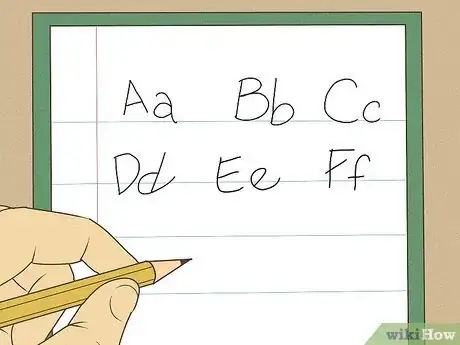

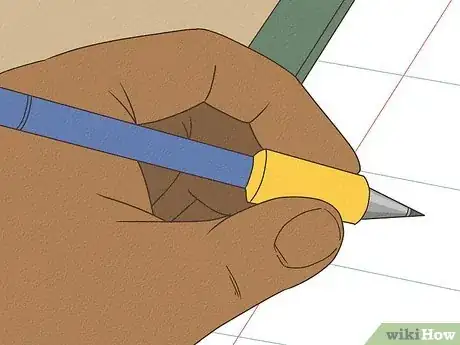
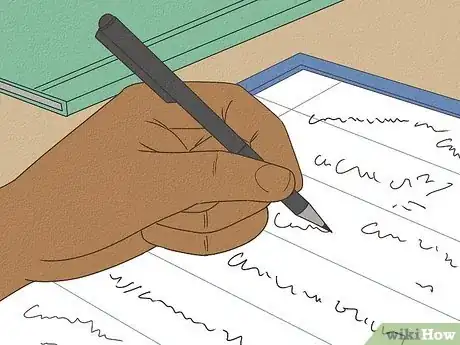





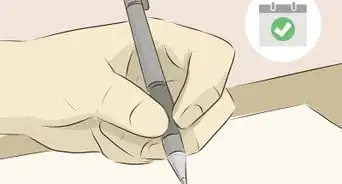

-Step-15-Version-3.webp)



















